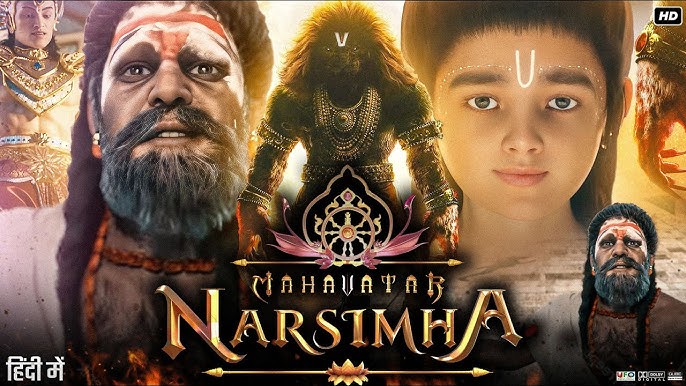At a time when audience fatigue towards mainstream Indian cinema is at an all-time high and footfalls into theatres are increasingly rare, Mahavatar Narsimha emerges not just as a film — but as a collective spiritual experience. This animated mythological saga reclaims the theatre space with a story that’s as visually powerful as it is emotionally resonant. Whether watched alone, as a family, or with friends seeking something profound, this film rekindles the magic of coming together for a cinematic journey.
Here’s why Mahavatar Narsimha deserves your attention — and why it’s winning hearts across all age groups:

1. A Bold Leap for Indian Animation
India has flirted with mythological animation before, but this film elevates the genre. With over four years in the making, every frame is detailed with depth and devotion. The grand cosmic landscapes, richly imagined divine realms, and stylized character animation strike a fine balance between artistic beauty and narrative clarity. It is a homegrown triumph in storytelling that doesn’t pander — it presents mythology with dignity and cinematic heft.
2. A Story That Speaks Across Ages and Eras
At the heart of the film lies the story of a child’s unwavering devotion, a demon king’s unchecked ego, and a cosmic force born out of divine justice. The legend of Prahlad and Hiranyakashipu unfolds with emotional intensity, without diluting the mythology or overwhelming the audience with sermonizing. It makes a powerful statement on faith over fear, compassion over cruelty, and surrender over control — messages that resonate more today than ever.
3. Voice Work That Transports You
Great animation needs more than visuals — it needs voices that breathe life into myth. The voice cast in Mahavatar Narsimha delivers with gravitas and grace, especially in moments of emotional pause or spiritual power. Dialogue delivery is rooted in Sanskritic elegance, yet flows with an emotional current that connects universally.
4. Music and Sound That Stir the Soul
The background score in this film doesn’t just accompany — it elevates. From serene chants to thunderous war cries, the sound design adds a sonic layer that uplifts every frame. The music doesn’t shy away from evoking devotion, but neither does it feel preachy. It hits you exactly where myth meets mood.
5. Direction with Purpose
Director Ashwin Kumar does something rare — he allows the story to breathe. The pacing is thoughtful, never rushing through its spiritual core. While the narrative could have taken a few tighter turns in its middle act, the director’s restraint and belief in the material are commendable. This is not animation for distraction; it is storytelling with conviction.
6. A Production House That Believes in the Power of Culture
Backed by a banner that has consistently pushed the envelope in Indian cinema, this production sets a new benchmark in creating culturally rooted yet globally styled cinematic experiences. From conceptualisation to execution, there’s a clear intent: to preserve, reinterpret, and celebrate our ancient wisdom for today’s and tomorrow’s audience.
7. Themes That Echo Beyond the Screen
In today’s age of hyper-individualism and rising cynicism, Mahavatar Narsimha calls us back to core human values — faith, surrender, humility, and the power of divine justice. It’s a film that doesn’t just entertain — it inspires reflection, especially among younger audiences who may be encountering these legends for the first time in such a compelling format.
Mahavatar Narsimha isn’t just an animated mythological film — it’s an invitation. An invitation to pause. To reflect. To feel awe again.
In an era dominated by noise, cynicism, and overstimulation, this film roars with soul and silence. It encourages dialogue, not distraction. It nudges us back to the theatre, not for spectacle alone — but for something sacred.
And maybe that’s what makes it most special. It brings together generations, not just for a film, but for a shared emotional and spiritual moment — something cinema was always meant to do.
The film releases in theatres across India in Hindi, Malyalam, Telugu, Tamil, and Kannada.









